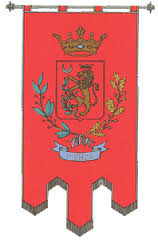Gonfalon Project: Difference between revisions
BaronGiles (talk | contribs) (Creation of page) |
BaronGiles (talk | contribs) m (added definition, image of an Italian gonfalon, plans for pole and base) |
||
| Line 1: | Line 1: | ||
{{regalia|photo=[[Image: | {{regalia|photo=[[Image:GonfalonDePiensa.jpg|300px]]|photocaption=A gonfalon bearing the arms of the commune of Piensa, Tuscany, Italy.|status=Active|artist=[[unknown]] }} | ||
Inspired by a desire to simultaneously beautify Caid and answer the eternal question "What are we going to present at PhelanLeBlanc Anniversary next week?" the Barons of Gyldenholt ([[Giuseppe Francesco da Borgia]] and [[Giles Hill]] created the Gyldenholt Gonfalon Project, with the ambitious goal of presenting every Barony with two gonfalons bearing that Barony's arms. | Inspired by a desire to simultaneously beautify Caid and answer the eternal question "What are we going to present at PhelanLeBlanc Anniversary next week?" the Barons of Gyldenholt ([[Giuseppe Francesco da Borgia]] and [[Giles Hill]]) created the Gyldenholt Gonfalon Project, with the ambitious goal of presenting every Barony with two gonfalons bearing that Barony's arms. Gonfalons (from the early Italian confalone) are --quoting Wikipedia|https://en.wikipedia.org/wiki/Gonfalon -- a type of heraldic flag or banner, often pointed, swallow-tailed, or with several streamers, and suspended from a crossbar in an identical manner to the ancient Roman vexillum. It was first adopted by Italian medieval communes, and later, by local Guilds, Corporations and Districts. The difference between a gonfalon with long tails and a standard is that the gonfalon displays the device on the non-tailed area, and the standard displays badges down the whole length of the flag. | ||
==Specifications for Gonfalons== | ==Specifications for Gonfalons== | ||
Finished dimensions are | Finished dimensions are 20" by 23" (not including the loops at the top of the banner). Plans for constructing the poles and base are | ||
[[Plans|GonfalonPolePlan.jpg]] | |||
==Baronial Arms on the Gonfalons== | ==Baronial Arms on the Gonfalons== | ||
Revision as of 13:11, 18 October 2015
| Regalia | ||||
|---|---|---|---|---|
 A gonfalon bearing the arms of the commune of Piensa, Tuscany, Italy. | ||||
| Information | ||||
|
Inspired by a desire to simultaneously beautify Caid and answer the eternal question "What are we going to present at PhelanLeBlanc Anniversary next week?" the Barons of Gyldenholt (Giuseppe Francesco da Borgia and Giles Hill) created the Gyldenholt Gonfalon Project, with the ambitious goal of presenting every Barony with two gonfalons bearing that Barony's arms. Gonfalons (from the early Italian confalone) are --quoting Wikipedia|https://en.wikipedia.org/wiki/Gonfalon -- a type of heraldic flag or banner, often pointed, swallow-tailed, or with several streamers, and suspended from a crossbar in an identical manner to the ancient Roman vexillum. It was first adopted by Italian medieval communes, and later, by local Guilds, Corporations and Districts. The difference between a gonfalon with long tails and a standard is that the gonfalon displays the device on the non-tailed area, and the standard displays badges down the whole length of the flag.
Specifications for Gonfalons
Finished dimensions are 20" by 23" (not including the loops at the top of the banner). Plans for constructing the poles and base are GonfalonPolePlan.jpg
Baronial Arms on the Gonfalons
- ImageName.JPG
CaptionText
Blazon and registration date.
Maker: Somebody - ImageName.JPG
CaptionText
Blazon and registration date.
Maker: Somebody - ImageName.JPG
CaptionText
Blazon and registration date.
Maker: Somebody
Gonfalon Gallery
- ImageName.JPG
CaptionText
Blazon and registration date.
Maker: Somebody